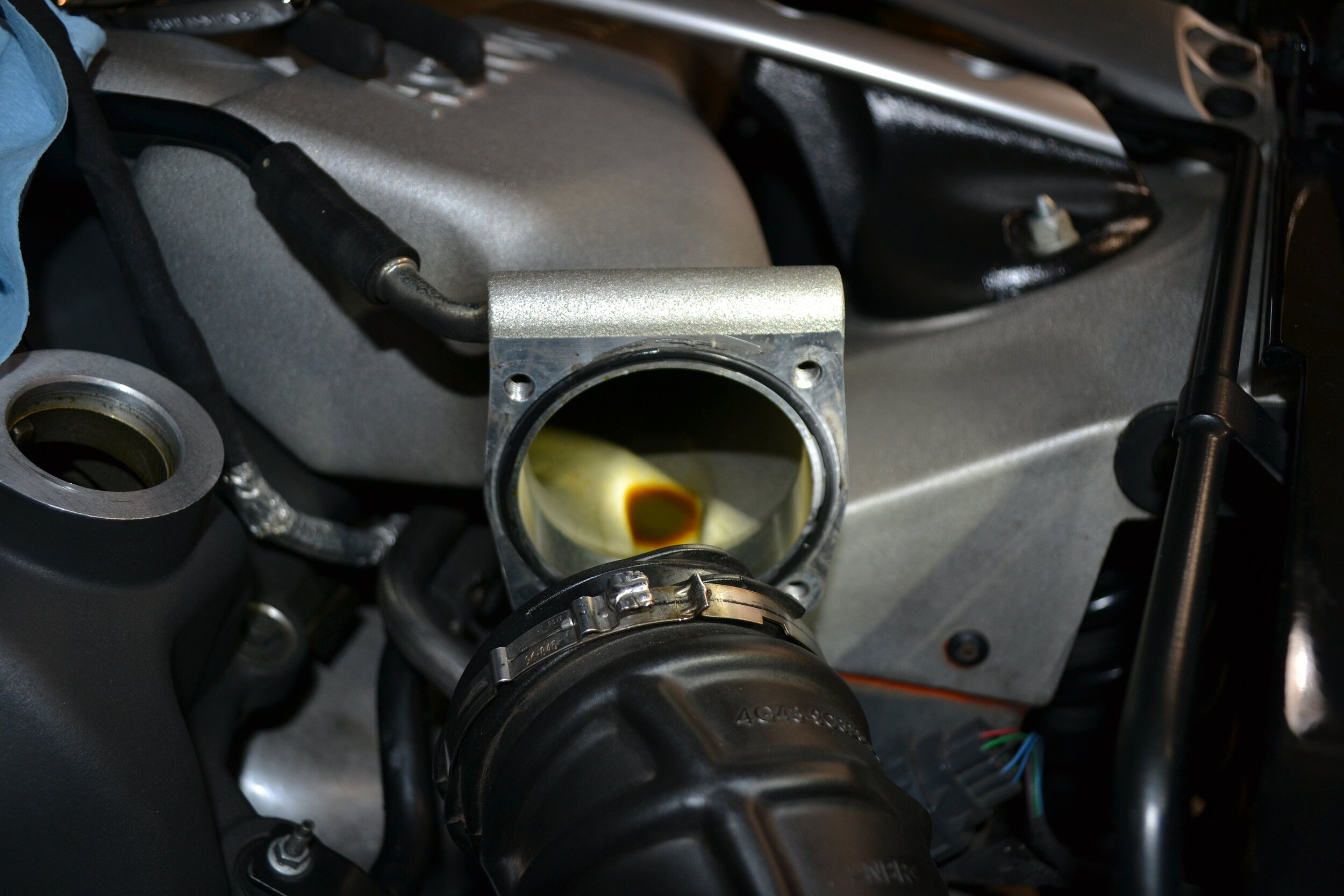
Don’t Breathe the Oil Vapors
DISCLAIMER
The information provided here is for general guidance purposes only. It is a combination of manufacturer guidance, first- and second-hand experience, and personal opinion. It may me inaccurate, incomplete, or outdated.
An air-oil separator (AOS) is a small component connected to the engine that, as the name suggests, separates oil vapors from the air that passes through it. Aston Martins have these and they work... in theory. In this article I'll be talking about the failings of the OEM air-oil separator, a common leaking problem, and how to fix both.
To get things started, let's take a look at the AOS in the V8 Vantage. It's the smaller of the two flat-topped plastic components, circled in the picture below.
The Problem
Just kidding, it's more than one problem. There are actually two problems with the OEM AOS.
It leaks, and
It doesn't work very well.
The AOS is held in place by a single bolt, which means it doesn't have positive pressure on both sides of its inlet. As the AOS vibrates from the engine and heat cycles from heating and cooling, it eventually lets oil seep past its single O-ring which isn't properly sealing because it's only got a single bolt on one single side keeping it in place.
The good thing is that it's a very small amount of oil that gets out. However, oil cakes the bottom half of the AOS as well as the drain tube coming from the bottom of the AOS and the oil collects dirt and grime that build up on both.
Such a thing can be considered simply an annoyance - you'd only ever notice it when you stick your hand down there... for whatever reason... and come up with a smear of thick black, oily grime on your hand. Here's how to fix the AOS. It's a quick, easy job. But more than just an annoyance is the fact that the air-oil separator doesn't really work too well.
To sum up what an air-oil separator does as quickly as possible:
Hot, pressurized air is vented from the engine to relieve excess air pressure that can lead to a number of issues. That air contains oil vapors. The oil vapors can't be vented to atmosphere because of emissions. So the air goes through an air-oil separator that is supposed to remove those oil vapors and return them, as oil, to the oil sump. The cleaner air is then sent into the intake manifold to be burned off, with any trace oil being burned in the process. However, the OEM AOS doesn't quite accomplish this. Plus, the AOS is bypassed by at least one vent line. So, there's that.
Why does this matter? Because the oil vapors contaminate the intake air/fuel mixture, which affects everything from engine power to fuel efficiency to emissions.
The Solution
A few years ago I pulled my throttle body off the intake manifold to give it a nice cleaning. When I looked into the manifold I saw a depression, a hole of some kind. As I often do when I'm curious about such things... I stuck my finger in it. Oil covered my finger, which shouldn't really happen when poking around in an intake manifold.
I started investigating the source of the oil. I pulled off the EGR solenoid and diddled that. It was clean. I pulled open the plastic tubes leading into the intake duct and diddled those. Also clean. Then I pulled off the plastic tube connecting the PCV to the intake manifold. The diddle was dirty!
I decided I needed to fix the problem… I needed to come up with a way to prevent oil from getting into the intake manifold. I started doing some research, poring over parts diagrams, and looking for solutions. I eventually designed an oil catch can using a custom mounting bracket, OEM fittings, and off-the-shelf components. I tested the setup on my car and it worked really well. I posted my project on an online forum, and a bunch of people were interested. I sold a batch of the kits and then went with a more customized route. The end result is the Redpants Oil Catch Can Kit, which became my first product for Aston Martins and was the genesis of Redpants as a company. It blends in perfectly with the engine bay - most people don't know it's aftermarket! Here's what it looks like installed. (It's the black cannister down by the power steering reservoir.)
The internal baffling causes the oil vapors to condensate into liquid oil, which then collect in the bottom half of the catch can where they’re stored until the catch can is drained.
Does it work? Absolutely yes. I included some discussion about the results in this video about cleaning the throttle body, which is partly caused by oil vapors.
It's shocking to see how much oil gets through the system!
The catch can isn’t perfect - some oil will still continue to get past it. However, the amount getting through is greatly reduced. I was happy with the results of the catch can as creating a more “perfect” solution would require more cost, complexity, and maintenance, quickly resulting in diminishing returns.
I’ve been using the catch can on my grey 2007 V8 Vantage for several years (it was the first to get one, after all) and it’s done extremely well over all this time. Maintenance is simple as it just needs to be drained occasionally - I recommend draining it as part of the annual oil change, but it can be done less often for many cars that aren’t driven much.
Why There Aren’t Any Factory Catch Cans
While cars are built with air-oil separators, you won’t ever see one with a factory-equipped catch can. The reason is because a catch can must be maintained (drained) and lack of maintenance can cause serious issues.
There are two types of fluid in a vehicle: Those that are consumed and refilled, and those that are used until replaced.
Gas (petrol) and windshield washer fluid are fluids that are consumed and refilled. Engine oil and coolant are fluids that are used until replaced. A catch can introduces a third type of fluid: one that is collected and stored until drained. This is something you’ll never see on a factory vehicle because it introduces risks that lay outside what would be acceptable to a manufacturer.
A catch can’s job is to filter air that goes from one part of the engine to another. If the catch can is neglected and the fluid inside fills up so much that it blocks the air passageway, then it can cause serious issues with the engine.
There are factory-equipped catch cans on some vehicles, like the Vantage GT4 race car, but race teams are far more meticulous about maintenance than a normal Aston Martin owner so it’s acceptable for those cars to have them.





